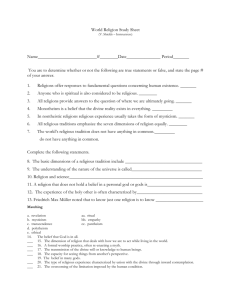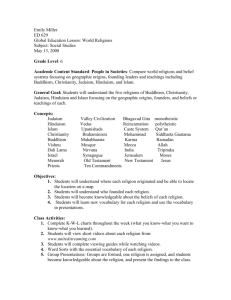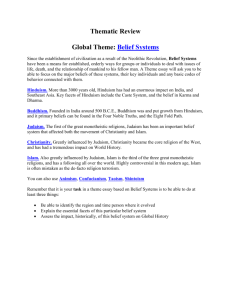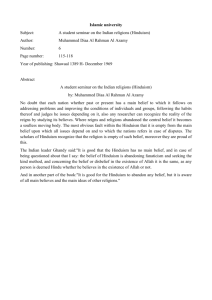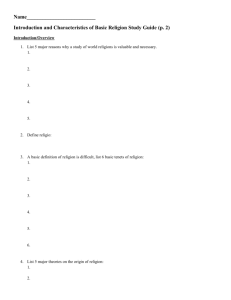Religions and Belief Systems Summary Chart - ODE IMS
advertisement
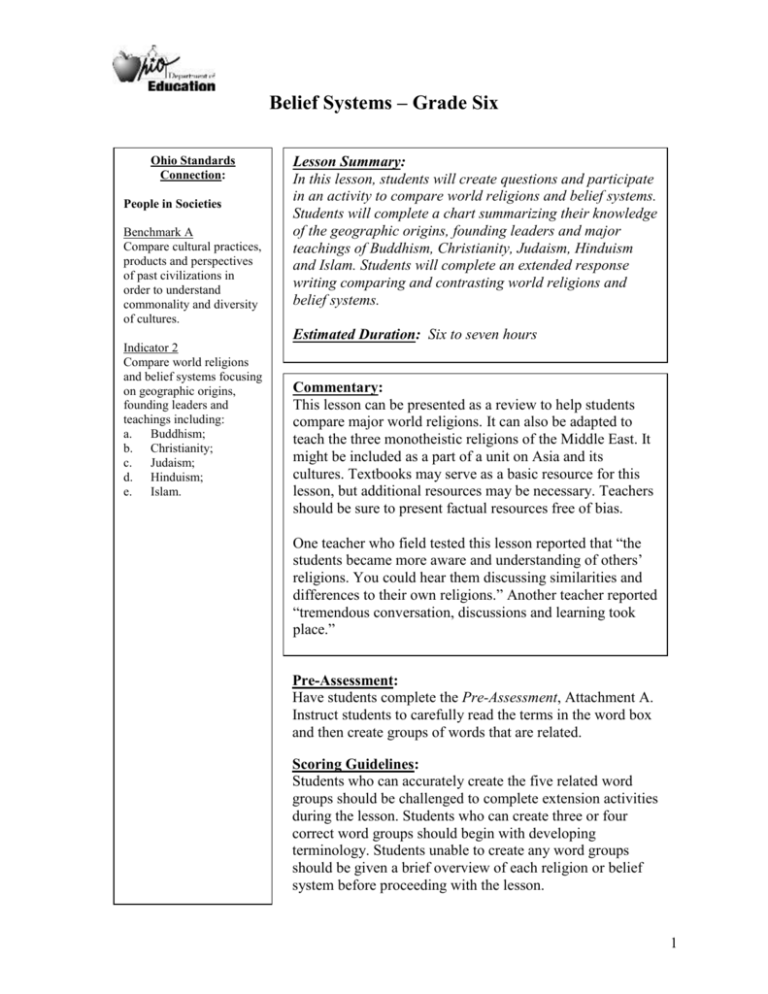
Belief Systems – Grade Six Ohio Standards Connection: People in Societies Benchmark A Compare cultural practices, products and perspectives of past civilizations in order to understand commonality and diversity of cultures. Lesson Summary: In this lesson, students will create questions and participate in an activity to compare world religions and belief systems. Students will complete a chart summarizing their knowledge of the geographic origins, founding leaders and major teachings of Buddhism, Christianity, Judaism, Hinduism and Islam. Students will complete an extended response writing comparing and contrasting world religions and belief systems. Estimated Duration: Six to seven hours Indicator 2 Compare world religions and belief systems focusing on geographic origins, founding leaders and teachings including: a. Buddhism; b. Christianity; c. Judaism; d. Hinduism; e. Islam. Commentary: This lesson can be presented as a review to help students compare major world religions. It can also be adapted to teach the three monotheistic religions of the Middle East. It might be included as a part of a unit on Asia and its cultures. Textbooks may serve as a basic resource for this lesson, but additional resources may be necessary. Teachers should be sure to present factual resources free of bias. One teacher who field tested this lesson reported that “the students became more aware and understanding of others’ religions. You could hear them discussing similarities and differences to their own religions.” Another teacher reported “tremendous conversation, discussions and learning took place.” Pre-Assessment: Have students complete the Pre-Assessment, Attachment A. Instruct students to carefully read the terms in the word box and then create groups of words that are related. Scoring Guidelines: Students who can accurately create the five related word groups should be challenged to complete extension activities during the lesson. Students who can create three or four correct word groups should begin with developing terminology. Students unable to create any word groups should be given a brief overview of each religion or belief system before proceeding with the lesson. 1 Belief Systems – Grade Six Students should group the following words together: Judaism, Israel, Moses, Hebrew Buddhism, Four Noble Truths, Middle Way, Nirvana Islam, Mecca, Five Pillars, Muslim Christianity, Jesus, New Testament, Bible Hinduism, Reincarnation, Vishnu, Brahma Post-Assessment: Extended Response Writing Have students use the information from the Summary Chart to compose a five-paragraph extended response for one of the following topics. Option 1: For each of the five religions studied, describe the major ideas that make each religion different from other religions. Option 2: For each religion, describe one or more ideas that it shares with other religions. Scoring Guidelines: Use the rubric provided on Attachment F. Instructional Procedures: Days One, Two and Three 1. Administer the Pre-Assessment, Attachment A, and determine the best way to proceed with the lesson. In introducing the lesson, emphasize that we study belief systems because it helps us to understand cultures and to respect other religions. 2. Explain that the class will be divided into groups to research a religion or belief system and to create questions for an educational board game the class will play to enhance their knowledge. 3. Divide the class into five cooperative learning groups and assign a religion or belief system to each group (Buddhism, Christianity, Judaism, Hinduism, or Islam). 4. Distribute Religions and Belief Systems Summary Notes, Attachment B, to each student. Have students work as cooperative groups to determine responses to each part of the handout; have each student produce his or her own copy. 5. Instruct the groups to use their textbooks, reference books or encyclopedias to locate information. Circulate among groups assisting with note taking, offering additional information and checking student work for specific examples and details. Instructional Tip: This portion of the lesson may take a longer period of time. Determine the pacing based on classroom observation. It is strongly recommended that students read background information outside of class from their textbook or other source on all religions, not just the one they are researching in class. This background information will prepare students for the sharing session later in the lesson. 2 Belief Systems – Grade Six Days Four and Five 6. Distribute Religions and Belief Systems Questions, Attachment C, to each cooperative learning group. 7. Explain that each student will be responsible for composing at least one question. 8. Hold one student in each group responsible for creating a token that reflects or symbolizes the religion or belief system. For example, a lotus flower for Buddhism or a statue of Vishnu for Hinduism. 9. Collect the student-created questions and answers from the five groups. Review the questions and answers for content and clarity. 10. Have each group copy their teacher-approved questions and answers onto note cards and submit their cards to the teacher for use in the review activity. Days Six and Seven 11. Using a Jigsaw approach, organize new groups with one student from each of the five cooperative groups. 12. Have each student act as a reporter from their original group and share their notes from Attachment B. In this way, all students hear an overview of each religion or belief system. 13. Instruct students to complete the Religions and Belief Systems Summary Chart, Attachment D, as each student presents his or her information. Day Eight 14. Have students return to their cooperative learning groups for participation in the review activity. The activity may be conducted as a whole class, with learning groups as teams, or within learning groups with students playing individually. 15. Explain the review activity instructions and display the game board, Attachment E. Instructional Tip: The game board may be drawn on bulletin board paper and placed on the floor so the class can sit around the perimeter. The board could also be drawn by the separate groups on poster paper, allowing multiple groups to play at the same time on their own boards (cards would need to be copied in advance and multiple game pieces would need to be provided or created). Other options might include projecting the board from an overhead so that it is visible by the class. Review Activity Instructions: All groups place their token on the “Start” position and determine the order of play for their team. Each group will roll a die; the group with the highest number will go first. The group rolls the die and moves their token the appropriate number of spaces. The teacher asks a question from the corresponding cards. For example, if the first team rolls a four and lands on the “Hinduism” square, the teacher asks the question from the first card in the “Hinduism” stack. 3 Belief Systems – Grade Six The first person in order of play attempts to answer the question. If a correct answer is given, the token remains on the square. If an incorrect answer is given, the group has a chance to confer and to offer another answer. If a correct answer is given, the token remains on the square. If an incorrect answer is given, the group must move the token back to their previous position. Play proceeds in this way until one group completes the circuit around the board, winning the game. Other groups may continue playing until everyone has completed the circuit. 15. If playing as a whole class, read the questions aloud. When the first group completes a circuit around the board, have them declared the winner. Other groups may continue play until all have completed the game. 16. Have students complete the extended response part of their post-assessment, either in class or for homework. Distribute the writing rubric, Attachment F, and have students choose one of the following topics to write about: Option 1: For each of the five religions studied, describe the major ideas that make each religion different from other religions. Option 2: For each religion, describe one or more ideas that it shares with other religions. Differentiated Instructional Support: Instruction is differentiated according to learner needs, to help all learners either meet the intent of the specified indicator(s) or, if the indicator is already met, to advance beyond the specified indicators. Have students work in heterogeneous groups so students with various abilities can assist each other. Have students complete the Religions and Belief Systems Summary Chart, Attachment D, with pictures and words. For students working beyond the indicator, add historical summaries to note taking. Have students create a time line of major events or changes in world religions. Extensions: Cooperative groups might further research a holiday, celebration or rite of passage important to the belief system or religion they studied. Have students create Venn diagrams comparing belief systems. Homework Options and Home Connections: Have students research the presence of other religions in their local community, county or state. 4 Belief Systems – Grade Six Interdisciplinary Connections: Language Arts Writing Applications Benchmark D: Produce informational essays or reports that convey a clear and accurate perspective and support the main ideas with facts, details, examples and explanations. Indicator 4: Write informational essays or reports, including research, that present a literal understanding of the topic, include specific facts, details and examples from multiple sources and create an organizing structure appropriate to the purpose, audience and context. Materials and Resources: The inclusion of a specific resource in any lesson formulated by the Ohio Department of Education should not be interpreted as an endorsement of that particular resource, or any of its contents, by the Ohio Department of Education. The Ohio Department of Education does not endorse any particular resource. The Web addresses listed are for a given site’s main page, therefore, it may be necessary to search within that site to find the specific information required for a given lesson. Please note that information published on the Internet changes over time, therefore the links provided may no longer contain the specific information related to a given lesson. Teachers are advised to preview all sites before using them with students. For the teacher: Research materials. For the students: Research materials such as textbooks, reference books, encyclopedias, Internet access. Vocabulary: religion belief system Islam Hinduism Christianity Judaism Buddhism Five Pillars of Islam 10 Commandments Eight Fold Path Four Noble Truths reincarnation nirvana dharma hajj pilgrimage temple 5 Belief Systems – Grade Six mosque sanctuary church sacred holy land Technology Connections: Students could use electronic versions of the supporting documents instead of handouts. The extended response could be submitted electronically via email. The board game could be developed by students within drawing/painting software and then projected during the game activity. Research Connections: Marzano, R. et al. Classroom Instruction that Works: Research-Based Strategies for Increasing Student Achievement, Alexandria, VA: Association for Supervision and Curriculum Development, 2001. Nonlinguistic representations help students think about and recall knowledge. This includes the following: Creating graphic organizers; Making physical models; Generating mental pictures; Drawing pictures and pictographs; Engaging in kinesthetic activity. Elliot Aronson, The Jigsaw Classroom, Beverly Hills: Sage Publications, 1978. The Jigsaw method is one strategy for organizing cooperative learning groups. General Tips: Take extra care to treat all religions and belief systems with respect. Remind students of the importance of this. Be aware that many online sources of information related to belief systems are designed to promote particular viewpoints. Teachers should preview sites to be used by students. Background student reading from a text or other source is strongly recommended. Students should add notes from the text to the Religions and Belief Systems Summary Chart, Attachment D, to ensure their knowledge of all religions. Attachments: Attachment A, Pre-Assessment Attachment B, Religions and Belief Systems Summary Notes Attachment C, Religions and Belief Systems Questions Attachment D, Religions and Belief Systems Summary Chart Attachment E, Review Activity Attachment F, Extended Response Scoring Rubric 6 Belief Systems – Grade Six Attachment A Pre-Assessment Religions and Belief Systems Name: Directions: Carefully read the terms listed in the word box and then create five groups of words that are related. When you are finished, each group will have four related words in it. Israel Five Pillars Jesus Nirvana Buddhism Moses Middle Way Vishnu Mecca Hinduism Reincarnation Christianity Islam Bible Brahma Hebrew New Testament Judaism Four Noble Truths Muslim 1. ____________ ____________ ____________ ____________ 2. ____________ ____________ ____________ ____________ 3. ____________ ____________ ____________ ____________ 4. ____________ ____________ ____________ ____________ 5. ____________ ____________ ____________ ____________ 7 Belief Systems – Grade Six Attachment B Religions and Belief Systems Summary Notes Name: ________________________________________ Group Members: ___________________________________________________________ Belief or Religion: _____________________________________________________ Directions: Use your textbook, reference books, encyclopedias or online sources to complete the following information. Your group members may share information as long as everyone completes a worksheet. 1. Identify the geographic origins of your assigned belief or religion. 2. Identify the founding leader(s) of your assigned belief or religion. 3. Identify and describe any important books or writings. 4. Identify and describe any goals, rewards or ultimate states that followers try to achieve. 5. Identify any rules or guidelines that should be followed. 6. Identify and explain any major holidays or observances. 7. Identify and describe any other major traditions. 8. Explain any other noteworthy information. 8 Belief Systems – Grade Six Attachment C Religions and Belief Systems Questions Group Members: ________________________________________________________ Belief or Religion: _______________________________________________ Directions: As a group, create questions about your assigned topic that fulfill each requirement. Each group member must take responsibility for composing at least one question and one answer. The goal of the questions is to focus on the most important information from the Summary Notes. Avoid questions that can be answered with a simple yes or no and questions that require overly specific answers. The goal is to teach, not to trick. 1. Compose ONE question and answer related to the geographic origins of the assigned belief system or religion. 2. Compose ONE question and answer related to the leader(s) of the assigned belief system or religion. 3. Compose THREE questions and answers related to the major teachings of the assigned belief system or religion. 1. 2. 3. 9 Belief Systems – Grade Six Attachment D Religions and Belief Systems Summary Chart Name: ____________________________________ Directions: In your group, give each person an opportunity to share the information from their Summary Notes. Complete each portion of the chart in order to expand your knowledge of each religion or belief system. You may use additional paper if necessary. Geographic Origins Founding Leaders Major Teachings (Include at least 3 details.) Buddhism Christianity Judaism Hinduism Islam 10 Belief Systems – Grade Six Attachment E Review Activity Islam Hinduism Judaism Christianity Buddhism Start Buddhism Islam Christianity Hinduism Judaism Judaism Hinduism Christianity Islam Buddhism Buddhism Islam Christianity Hinduism Judaism Hinduism Islam Buddhism Christianity Judaism 11 Belief Systems – Grade Six 12 Belief Systems – Grade Six Attachment F Extended Response Scoring Rubric 4 points Uses a strong explanatory introduction, thorough details, logical organization and uses the summary chart extensively. 3 points Uses an explanatory introduction, details, and logical organization. Demonstrates use of the summary chart. Paragraph Two Uses a strong explanatory introduction, thorough details, logical organization and uses the summary chart extensively. Uses an explanatory introduction, details, and logical organization. Demonstrates use of the summary chart. Paragraph Three Uses a strong explanatory introduction, thorough details, logical organization and uses the summary chart extensively. Uses an explanatory introduction, details, and logical organization. Demonstrates use of the summary chart. Paragraph Four Uses a strong explanatory introduction, thorough details, logical organization and uses the summary chart extensively. Uses an explanatory introduction, details, and logical organization. Demonstrates use of the summary chart. Paragraph Five Uses a strong explanatory introduction, thorough details, logical organization and uses the summary chart extensively. Uses an explanatory introduction, details and logical organization. Demonstrates use of the summary chart. Edited for spelling, grammar and punctuation No spelling or grammar errors. Few spelling or grammar errors. Paragraph One 2 points Attempts an introduction, uses details, and somewhat logical organization. Demonstrates some use of the summary chart. Attempts an introduction, uses details, and somewhat logical organization. Demonstrates some use of the summary chart. Attempts an introduction, uses details, and somewhat logical organization. Demonstrates some use of the summary chart. Attempts an introduction, uses details, and somewhat logical organization. Demonstrates some use of the summary chart. Attempts an introduction, uses details and somewhat logical organization. Demonstrates some use of the summary chart. Spelling, grammar and punctuation need more work. 1 points Use of introduction, details and organization needs more work. Needs greater attention to the summary chart. Use of introduction, details and organization needs more work. Needs greater attention to the summary chart. Use of introduction, details and organization needs more work. Needs greater attention to the summary chart. Use of introduction, details and organization needs more work. Needs greater attention to the summary chart. Use of introduction, details and organization needs more work. Needs greater attention to the summary chart. Spelling, grammar and punctuation need significant revision. 13
